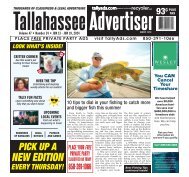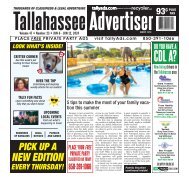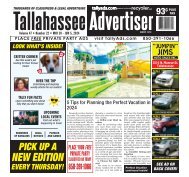TLA32_AllPages_R
Create successful ePaper yourself
Turn your PDF publications into a flip-book with our unique Google optimized e-Paper software.
There are several things that could hasten the demise of the great<br />
freight environment.<br />
One of those, both Vieth and Costello said, is if trade skirmishes<br />
become an all-out trade war.<br />
The National Retail Federation is also concerned about what<br />
tariffs will do to commerce.<br />
That being said, however, the number of imports at the nation’s<br />
major retail container ports have set two new records highs this<br />
summer and are expected to set another record high for August,<br />
according to the monthly Global Port Tracker report released August<br />
9 by the National Retail Federation and Hackett Associates.<br />
Tax reform and a thriving economy are mostly driving retail sales,<br />
the report said, but part of it seems to be concern over what’s to come<br />
as far as tariffs and trade policies.<br />
Then there’s the supply-and-demand seesaw.<br />
“You know, the higher the cliff the bigger the fall,” Vieth said.<br />
“Our model says that there are about the number of tractors in the<br />
field today relative to the work to be done.”<br />
On the other hand, from this past March to May, the build-out of<br />
tractors decreased because parts manufacturers couldn’t find enough<br />
workers. In June, there was an uptick as more tractors came off<br />
the assembly lines with all their needed components. Before that,<br />
tractors coming off the line were missing various cab components,<br />
even windshields, Vieth noted.<br />
A significant concern he has is the rate of inflation, which could<br />
also blunt the freight boom. Then there are factors like the health of<br />
other industries that impact trucking, like the housing market.<br />
“We just saw the housing starts in the building permits numbers,”<br />
he said, and “they were kind of soft, and the rising interest rates and<br />
the inability to find construction workers and rising home prices”<br />
could mean the economy is starting to slow down.<br />
By the third quarter of 2019, certainly, this freight up-cycle is<br />
“going to be kind of long in the tooth,” Vieth said.<br />
At some point, the industry’s ability to attract drivers will go up<br />
and “at some point freight’s going to roll over and those two lines<br />
will cross. So it’s not a question of if, it’s a question of when.”<br />
A bellwether of when that will happen has to do with interest<br />
rates, Vieth explained.<br />
“Bankers borrow money at short-term rates and they lend money<br />
at long-term rates.” So as long as long-term rates are higher than<br />
short-term rates, things are OK. But “when you get the yield curve to<br />
where the short-term rate is higher than the long-term rate, bankers<br />
are no longer making money on lending.” When that happens,<br />
credit conditions tighten as banks stop lending money, capital dries<br />
up, projects sit for lack of funding and the economy heads toward<br />
recession.<br />
But then nobody has a crystal ball. So stay tuned.<br />
MAN WITH A PLAN<br />
Rep. Bill Shuster, chairman of the House Transportation and<br />
Infrastructure Committee, has drafted “Building a 21st Century<br />
infrastructure,” which isn’t a bill, rather a product of vast amounts<br />
of discussion that have already taken place among his legislative<br />
colleagues from both sides of the aisle, as well with numerous<br />
stakeholders from throughout the nation, he said.<br />
Set to retire next year, Shuster hopes his plan will spur Congress<br />
to finally come up with an infrastructure bill.<br />
The problem, Shuster wrote, is political and bureaucratic red tape<br />
that can delay progress for years, especially when so many opinions<br />
are being floated.<br />
He said the draft is meant to reignite discussions amongst his<br />
colleagues, and he urged “all members to be open-minded and<br />
willing to work together in considering real solutions that will give<br />
America the modern-day infrastructure it needs.”<br />
It calls for the formation of a Highway Trust Fund Commission<br />
that will recommend to Congress ways to achieve long-term solvency<br />
of the HTF, as well as for a provision that allows for Congress to<br />
expedite consideration of legislation on the matter.<br />
The discussion plan calls for the establishment of a national,<br />
volunteer-based pilot program to see whether a per-mile user fee<br />
could be a viable replacement for the existing user fees on gasoline<br />
and diesel. The volunteer-based program would be administered by<br />
the Secretary of Transportation in coordination with the Secretary of<br />
the Treasury.<br />
It also calls for an increase in federal user fees on gasoline and<br />
diesel by 15 and 20 cents, respectively, phased in over a three-year<br />
period, along with similar user fees on alternative fuels. The tax<br />
would end in 2028.<br />
Tca 2018 www.Truckload.org | TRUCKLOAD AUTHORITY 15

















